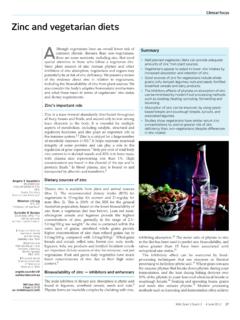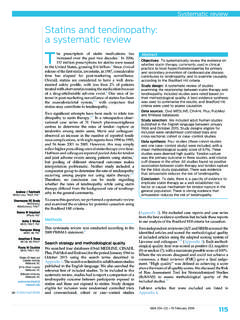Transcription of NHMRC additional levels of evidence and grades for …
1 NHMRC additional levels of evidence and grades for recommendations for developers of guidelines STAGE 2 CONSULTATION. Early 2008 end June 2009. Introduction The National Health and Medical Research Council ( NHMRC ) in Australia has, over recent years, developed a suite of handbooks to support organisations involved in the development of evidence - based clinical practice guidelines ( ). Reflecting the general impetus of the past decade, these handbooks focus predominantly on assessing the clinical evidence for interventions. As a consequence, the handbooks present levels of evidence ' appropriate mainly for intervention studies. However, feedback from guideline developers received by the NHMRC has indicated that the levels of evidence used by the NHMRC for intervention studies have been found to be restrictive. This is particularly so where the areas of study do not lend themselves to research designs appropriate to intervention studies ( randomised controlled trials).
2 As an interim measure to a review of the handbooks, this paper presents a forward-thinking approach to classifying levels of evidence , and grading evidence recommendations, which should be relevant to any clinical guideline (not just those dealing with interventions). The NHMRC is committed to addressing this issue and any other relevant concerns when all of the handbooks are reviewed. This consultation draft has been developed based on a Pilot Program on NHMRC additional levels of evidence and grades for recommendations for developers of guidelines ', which was initially released for public consultation in 2005, until mid-2006 with feedback sought until 30 June 2007 on their usability and applicability. levels of evidence guidelines can have different purposes, dealing with clinical questions such as intervention, diagnosis, prognosis, aetiology and screening.
3 To address these clinical questions adequately, guideline developers need to include different research designs. This consequently requires different evidence hierarchies that recognise the importance of research designs relevant to the purpose of the guideline. A new evidence hierarchy was subsequently developed in 2005 by the NHMRC Guideline Assessment Register (GAR) consultants. This hierarchy assigns levels of evidence according to the 1. type of research question, recognising the importance of appropriate research design to that question. As well as the current NHMRC levels of evidence for interventions, new levels have been developed for studies relevant for guidelines on diagnosis, prognosis, aetiology and screening. This consultation framework outlines the expanded levels of evidence , and provides additional information in the form of table notes, a study design glossary and a summary of how the levels of evidence and other NHMRC dimensions of evidence should be used (see Part A).
4 grades of recommendations To further assist guideline developers to make judgments on the basis of the body of evidence relevant to a research question, a grading system for recommendations has been developed (see Part B). This takes the form of an evidence matrix, which lists the evidence components that should be considered when judging the body of evidence . The grade of a recommendation is based on an overall assessment of the rating of individual components of the evidence matrix. Feedback A draft of the revised levels of evidence and new grading system for recommendations was posted on the NHMRC website from 2005 until mid-2007, with feedback being sought internationally on their usability and applicability. Several guideline development teams, with guidance from their GAR consultant, tested the revised levels and grades of evidence in guidelines that were developed during the pilot period.
5 The website feedback and the practical experience of guideline developers support the clinical utility and academic rigour of the new levels of evidence , and the grades of recommendation. This revised levels of evidence and grading system for recommendations which has been amended based on submissions received from the first pilot consultation, is now released for a second stage consultation from early 2008 to 30 June 2009. Submissions on the Stage 2 consultation draft can be submitted to the NHMRC at: with the heading: Att Project Officer, levels &. grades public consultation Stage 2. NHMRC or other guidelines that are developed using this consultation framework must include a statement at the front of the document explaining that the guidelines were developed using this consultation framework, which blends the official NHMRC levels with the interim' levels of evidence and grading system for recommendations.
6 Authors Kristina Coleman, Sarah Norris, Adele Weston - Health Technology Analysts Pty Ltd Karen Grimmer-Somers, Susan Hillier - Division of Health Sciences, University of South Australia Tracy Merlin - Adelaide Health Technology Assessment (AHTA), Discipline of Public Health, University of Adelaide Philippa Middleton, Rebecca Tooher - ASERNIP-S. Janet Salisbury - Biotext Acknowledgments: (a) Feedback has been provided during this document's development phase from the following: Marita Broadstock New Zealand Health Technology Assessment Suzanne Dyer NHMRC Clinical Trials Centre Paul Glasziou Oxford University, United Kingdom Brian Haynes McMaster University, Canada Paul Ireland National Institute of Clinical Studies 2. Nicki Jackson Deakin University Sally Lord and Les Irwig University of Sydney Skye Newton and Janet Hiller University of Adelaide Andrew Oxman Oslo, Norway (GRADE Working Group).
7 (b) Significant contribution to the revision of the pilot for the Stage 2 Consultation was provided during July-December 2007 by members of the NHMRC Guideline Assessment Register (GAR) panel organisations: Division of Health Sciences, Faculty of Health Sciences, The University of South Australia University of Adelaide: 1) Quality Use of Medicines and 1) Australian Research Centre for Pharmacy Research Centre Health of Women and Babies - Dr Agnes Vitry (ARCH), Discipline of Obstetrics &. - Ms Simone Rossi Gynaecology, School of Paediatrics and Reproductive Health 2) Centre for Allied Health evidence - Prof Caroline Crowther - Prof Karen Grimmer-Somers - Ms Philippa Middleton - Dr Susan Hillier - Dr Rebecca Tooher - Dr Caroline Smith - Dr Saravana Kumar 2) Adelaide Health Technology - Dr Nicola Massy-Westropp Assessment (AHTA)
8 , Discipline of - Mr Peter Lekkas Public Health, School of Population Health and Clinical Practice - Prof Janet Hiller - Ms Tracy Merlin - Dr Peng Bi - Ms Skye Newton Health Technology Analysts Pty Ltd Biotext Pty Ltd - Dr Ad le Weston - Dr Janet Salisbury - Dr Sarah Norris - Dr Hilary Cadman - Dr Kristina Coleman - Dr Fiona Mackinnon The work on this project is being managed by the evidence Translation Section, and supported by National Institute of Clinical Studies Officers of the NHMRC . 3. PART A. Implementing NHMRC dimensions of evidence including new interim' levels of evidence This part of the document outlines how individual studies included in a systematic literature review should be assessed using the NHMRC dimensions of evidence and provides levels of evidence appropriate for the most common types of research questions.
9 The basic principles of systematic reviewing and assessing evidence are set out in the NHMRC handbook series on the development of clinical practice guidelines ( NHMRC 2000ab). Dimensions of evidence for assessing included studies Each included study in a systematic review should be assessed according to the following three dimensions of evidence : 1. Strength of evidence a. Level of evidence : Each study design is assessed according to its place in the research hierarchy. The hierarchy reflects the potential of each study included in the systematic review to adequately answer a particular research question, based on the probability that its design has minimised the impact of bias on the results. See page 6 10 of How to use the evidence : assessment and application of scientific evidence ( NHMRC 2000b). The currently available NHMRC levels of evidence for intervention studies ( NHMRC .)
10 2000b), together with the new levels of evidence for questions on diagnosis, prognosis, aetiology and screening are shown in the evidence hierarchy in Table 1. b. Quality of evidence (risk of bias): The methodological quality of each included study is critically appraised. Each study is assessed according to the likelihood that bias, confounding and/or chance may have influenced its results. The NHMRC toolkit How to review the evidence : systematic identification and review of the scientific literature ( NHMRC 2000a) lists examples of ways that methodological quality can be assessed. In cases where other critical appraisal approaches may be required, there are a number of alternatives. The NHMRC Guideline Assessment Register consultant can advise on the choice of an alternative to supplement and/or replace those in the NHMRC handbook (see Table 2).

















